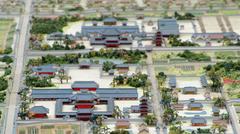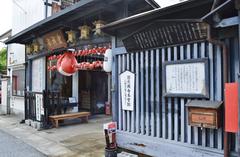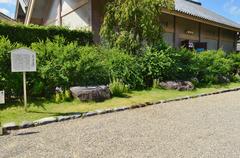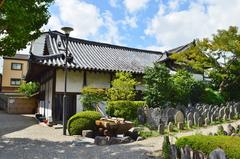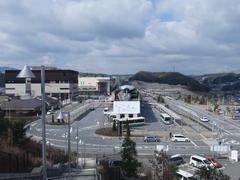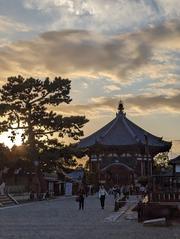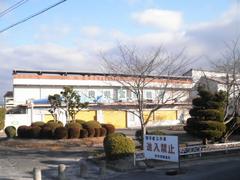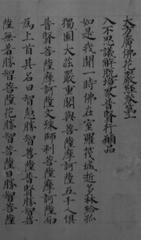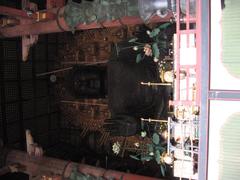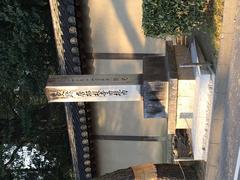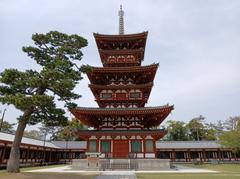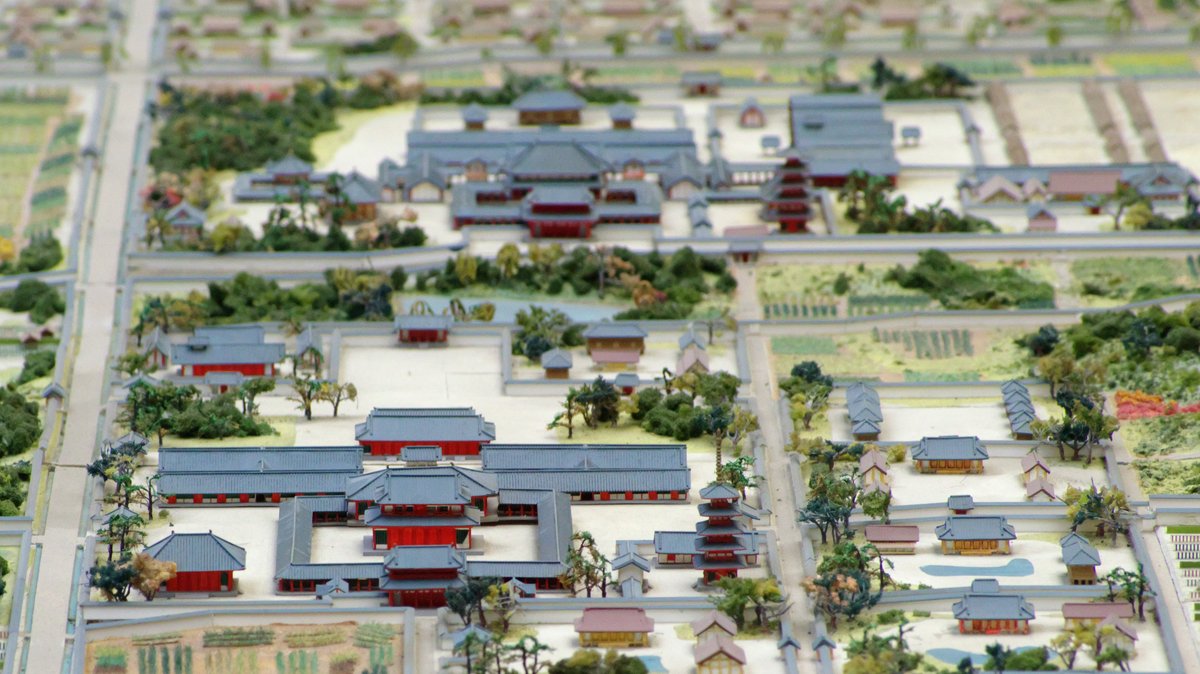
Gangō-Ji Temple in Nara: Visiting Hours, Tickets, and Comprehensive Guide
Introduction
Gangō-Ji Temple, nestled in Nara’s historic Naramachi district, stands as one of Japan’s earliest Buddhist temples and a celebrated UNESCO World Heritage Site. Its centuries-old halls, tranquil gardens, and storied relics offer a profound window into the origins of Japanese Buddhism, the evolution of temple architecture, and the living traditions that continue to shape Nara’s cultural identity. This comprehensive guide details Gangō-Ji’s rich history, architectural highlights, visiting hours, ticket information, accessibility, and travel tips to ensure a rewarding visit to one of Nara’s most captivating historical sites (Gangoji Official History; Japan Experience; Visit Nara).
Historical Overview
Foundations and Early Significance
Gangō-Ji traces its origins to the late 6th century, when Buddhism was first introduced to Japan. Established as Hōkō-ji (Asuka-dera) under the patronage of the Soga clan and Emperor Suiko, the temple marked a pivotal turn in Japanese religious and political history. The Soga’s embrace of Buddhism, aided by artisans and architects from China and Korea, positioned Gangō-Ji as a center for religious propagation and cultural exchange (Gangoji official about; Japan Experience).
Relocation and Flourishing in Nara
Following the capital’s move to Heijō-kyō (Nara) in 710 CE, Hōkō-ji was reconstructed as Gangō-Ji. It became one of the “Seven Great Temples of Nanto,” shaping the religious, intellectual, and architectural landscape of the Nara period (710–794). Gangō-Ji’s precincts once covered vast grounds, housing lecture halls, pagodas, and living quarters for monks, and serving as a hub for Buddhist learning and ritual (2 Aussie Travellers).
Decline and Preservation
Despite its early prominence, Gangō-Ji faced decline from the medieval era onward due to fires, wars, and urban encroachment. By the 19th century, much of its former grandeur was lost, leaving only a fraction of the original structures. Preservation efforts in the 20th century, particularly after World War II, led to the temple’s recognition as a National Treasure and, in 1998, its inscription on the UNESCO World Heritage list as part of the “Historic Monuments of Ancient Nara” (Gangoji official about).
Architectural Features and Treasures
Main Structures
- Gokuraku-dō (Main Hall): This National Treasure exemplifies the transition from Asuka to Nara architectural styles, blending ancient wooden beams, historic tiles, and Kamakura-period modifications. Inside, visitors can view Buddhist statuary, including a mandala and images of Amida Buddha (Gangoji Official; Japan Travel).
- Zen Room: Once the monks’ living quarters, this tranquil space features a garden with the “four gentlemen” plants and historic stones from the temple’s belfry (Gangoji Official).
- East Gate: An Important Cultural Property, this Kamakura-era gate was relocated from Todai-ji and showcases robust timber framing and symmetrical design (Gangoji Official).
- Miniature Pagoda: While the original five-story pagoda was destroyed in 1859, its base remains, complemented by a rare miniature pagoda from the Tempyo era—one of Japan’s smallest and a designated National Treasure (Visit Nara; Wikipedia).
Stone Monuments and Artistry
Gangō-Ji’s grounds host over 1,500 stone monuments, including Hōkyōintō (treasure towers), Jizō statues, and Amitabha images. These range from the Muromachi to Edo periods and play a central role in memorial services, such as the annual Jizō-e, where thousands of votive candles illuminate the temple (Gangoji Official).
Artistic Treasures
The temple’s treasure house contains important artifacts like the Chiko mandala, carved wooden Nara-period statues, and relics that illustrate the artistry and spiritual life of early Japanese Buddhism (Gangoji Official; Trek Zone).
Gardens and Natural Beauty
Gangō-Ji’s gardens, featuring the Yogo Sakura cherry tree and a tea ceremony space designed by Kawasaki Yugen, integrate historic stones into their landscape, blending natural beauty with the temple’s storied past (Gangoji Official).
Religious and Cultural Significance
As one of Japan’s earliest Buddhist temples, Gangō-Ji played a major role in establishing and spreading Buddhist doctrine. It was instrumental in the development of Buddhist festivals such as Obon and the Flower Festival (Kanbutsu-e), and its influence extended into the formation of the surrounding Naramachi merchant district (Japan Travel; Japan Experience).
Visiting Gangō-Ji: Practical Information
Location and Access
- Address: 11 Chuincho, Nara City, Nara Prefecture, 630-8392 (Gangoji Official)
- Getting There: 15-minute walk from Kintetsu Nara Station or 20 minutes from JR Nara Station; local buses serve the Naramachi area as well (Japan Travel).
Visiting Hours and Tickets
- Open: Daily, 9:00 a.m. to 5:00 p.m. (last admission at 4:30 p.m.)
- Tickets: Adults ¥500 (¥600 during special autumn exhibitions), junior/high school students ¥300, elementary students ¥100. Group and disabled visitor discounts available.
- Special Exhibitions: Often held in autumn, featuring additional artifacts and guided experiences. Check the official website for updates.
Accessibility and Facilities
- Physical Accessibility: The grounds are mostly flat but include some uneven stone paths and steps. Wheelchair access is available to major areas; inquire on-site for assistance.
- Facilities: Multilingual pamphlets and signage; restrooms near the entrance; no food or drink vendors on-site to preserve religious decorum—refreshments available in nearby Naramachi.
- Photography: Permitted in most outdoor areas; restrictions may apply inside halls. Always check posted signs.
Guided Tours and Learning
- Tours: English-language guided tours are not offered regularly but pamphlets and occasional audio guides are available. Consider joining a broader Nara walking tour that includes Gangō-Ji for deeper insight.
Cultural Etiquette and Tips for Visitors
- Conduct: Maintain quiet, respectful behavior. Remove hats and sunglasses when entering halls, and bow slightly at entrances.
- Dress: Modest, comfortable clothing and sturdy footwear are recommended.
- Best Times to Visit: Spring (March–May) and autumn (October–November) offer the best weather and garden views; winter is quieter; summer can be hot and humid.
Enhancing Your Visit
Exploring the Temple
Expect to spend 45–60 minutes exploring the main hall, Zen Room, gardens, and stone monuments. Art and history enthusiasts may linger longer to appreciate the temple’s extensive artifacts and tranquil ambiance.
Combining With Other Attractions
Gangō-Ji’s location in Naramachi makes it ideal for pairing with a stroll through the merchant district or visits to Kōfuku-ji, Nara Park, and the Nara National Museum—all within walking distance (Trek Zone).
Frequently Asked Questions (FAQ)
Q: What are Gangō-Ji’s visiting hours?
A: Open daily from 9:00 a.m. to 5:00 p.m., last admission at 4:30 p.m.
Q: How much are Gangō-Ji tickets?
A: Adults ¥500 (¥600 during certain exhibitions), junior/high school students ¥300, elementary students ¥100.
Q: Is Gangō-Ji wheelchair accessible?
A: The grounds are mostly flat, but some paths and halls may have limited access. Assistance is available onsite.
Q: Can I take photos inside the temple?
A: Photography is allowed outdoors; check for restrictions inside halls.
Q: Are English-language tours available?
A: Not regularly, but pamphlets and audio guides may be available. Consider joining a Nara walking tour for expert guidance.
Summary and Visitor Tips
Gangō-Ji Temple offers a serene, historically rich experience that bridges Japan’s ancient Buddhist traditions with contemporary cultural life. With accessible visiting hours, affordable tickets, and proximity to other Nara treasures, it’s an essential stop for anyone interested in the spiritual and artistic heritage of Japan. Plan your visit during spring or autumn for the most comfortable experience, and don’t miss exploring the nearby Naramachi district.
For a seamless, enriched journey, download the Audiala app for guided audio tours, maps, and insider travel tips. Explore related guides on Nara Park, Kōfuku-ji, and the best of Naramachi for a complete exploration of Nara’s historical heartland.
References and Further Resources
- Gangoji official history
- Gangoji official about
- 2 Aussie Travellers
- Japan Experience
- Japan Travel
- Visit Nara
- Wikipedia
- Trek Zone
- GaijinPot Gangō-Ji Temple Guide
- Japan Insides: Best Temples in Nara
- Next Level of Travel: Nara Itinerary
- Visit Nara: First Time Visitor Guide
Image Suggestions:
Include high-quality photos of the Gokuraku-dō Main Hall (alt: “Gangō-Ji temple main hall”), jizo statues and hidden oni in the garden (alt: “Gangō-Ji jizo statues in garden”), the Zen Room, East Gate, miniature pagoda, and a map showing Gangō-Ji’s location within Naramachi for optimal SEO.
